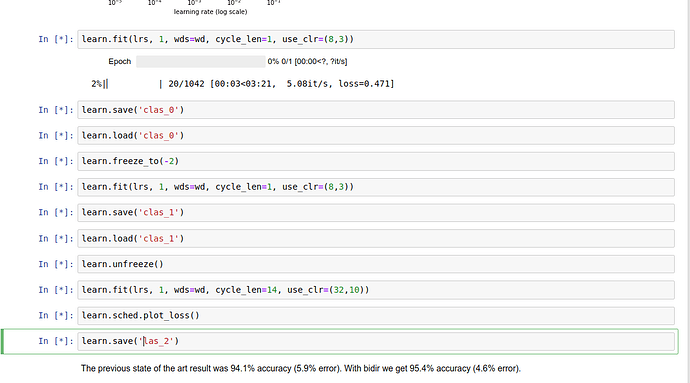Please help…
I tried to run imdb notebook on latest fastai version but when I want to run learner.fit(lrs/2, 1, wds=wd, use_clr=(32,2), cycle_len=1) I get an error. But in mooc version which uses previous versions of fastai and pytorch it runs fine. There is a mismatch between weights shapes. I tried to debug it and find out what happens to the weights, but so far no luck. self._flat_weights contains a list of weights with different shape of [4600,1150] or [4600] but it does not contain [5290000, 1]. maybe somewhere it gets flatten. I don’t know what really happens, so please help me.
RuntimeError Traceback (most recent call last)
in
----> 1 learner.lr_find(start_lr=lrs/10, end_lr=lrs*10, linear=True)
~/Desktop/fastai-master/courses/dl2/fastai/learner.py in lr_find(self, start_lr, end_lr, wds, linear, **kwargs)
343 layer_opt = self.get_layer_opt(start_lr, wds)
344 self.sched = LR_Finder(layer_opt, len(self.data.trn_dl), end_lr, linear=linear)
–> 345 self.fit_gen(self.model, self.data, layer_opt, 1, **kwargs)
346 self.load(‘tmp’)
347
~/Desktop/fastai-master/courses/dl2/fastai/learner.py in fit_gen(self, model, data, layer_opt, n_cycle, cycle_len, cycle_mult, cycle_save_name, best_save_name, use_clr, use_clr_beta, metrics, callbacks, use_wd_sched, norm_wds, wds_sched_mult, use_swa, swa_start, swa_eval_freq, **kwargs)
247 metrics=metrics, callbacks=callbacks, reg_fn=self.reg_fn, clip=self.clip, fp16=self.fp16,
248 swa_model=self.swa_model if use_swa else None, swa_start=swa_start,
–> 249 swa_eval_freq=swa_eval_freq, **kwargs)
250
251 def get_layer_groups(self): return self.models.get_layer_groups()
~/Desktop/fastai-master/courses/dl2/fastai/model.py in fit(model, data, n_epochs, opt, crit, metrics, callbacks, stepper, swa_model, swa_start, swa_eval_freq, visualize, kwargs)
139 batch_num += 1
140 for cb in callbacks: cb.on_batch_begin()
–> 141 loss = model_stepper.step(V(x),V(y), epoch)
142 avg_loss = avg_loss * avg_mom + loss * (1-avg_mom)
143 debias_loss = avg_loss / (1 - avg_mombatch_num)
~/Desktop/fastai-master/courses/dl2/fastai/model.py in step(self, xs, y, epoch)
48 def step(self, xs, y, epoch):
49 xtra = []
—> 50 output = self.m(*xs)
51 if isinstance(output,tuple): output,*xtra = output
52 if self.fp16: self.m.zero_grad()
~/.conda/envs/myroot36/lib/python3.6/site-packages/torch/nn/modules/module.py in call(self, *input, **kwargs)
475 result = self._slow_forward(*input, **kwargs)
476 else:
–> 477 result = self.forward(*input, **kwargs)
478 for hook in self._forward_hooks.values():
479 hook_result = hook(self, input, result)
~/.conda/envs/myroot36/lib/python3.6/site-packages/torch/nn/modules/container.py in forward(self, input)
90 def forward(self, input):
91 for module in self._modules.values():
—> 92 input = module(input)
93 return input
94
~/.conda/envs/myroot36/lib/python3.6/site-packages/torch/nn/modules/module.py in call(self, *input, **kwargs)
475 result = self._slow_forward(*input, **kwargs)
476 else:
–> 477 result = self.forward(*input, **kwargs)
478 for hook in self._forward_hooks.values():
479 hook_result = hook(self, input, result)
~/Desktop/fastai-master/courses/dl2/fastai/lm_rnn.py in forward(self, input)
104 with warnings.catch_warnings():
105 warnings.simplefilter(“ignore”)
–> 106 raw_output, new_h = rnn(raw_output, self.hidden[l])
107 new_hidden.append(new_h)
108 raw_outputs.append(raw_output)
~/.conda/envs/myroot36/lib/python3.6/site-packages/torch/nn/modules/module.py in call(self, *input, **kwargs)
475 result = self._slow_forward(*input, **kwargs)
476 else:
–> 477 result = self.forward(*input, **kwargs)
478 for hook in self._forward_hooks.values():
479 hook_result = hook(self, input, result)
~/Desktop/fastai-master/courses/dl2/fastai/rnn_reg.py in forward(self, *args)
122 “”"
123 self._setweights()
–> 124 return self.module.forward(*args)
125
126 class EmbeddingDropout(nn.Module):
~/.conda/envs/myroot36/lib/python3.6/site-packages/torch/nn/modules/rnn.py in forward(self, input, hx)
177 if batch_sizes is None:
178 result = _impl(input, hx, self._flat_weights, self.bias, self.num_layers,
–> 179 self.dropout, self.training, self.bidirectional, self.batch_first)
180 else:
181 result = _impl(input, batch_sizes, hx, self._flat_weights, self.bias,
RuntimeError: shape ‘[5290000, 1]’ is invalid for input of size 4600

